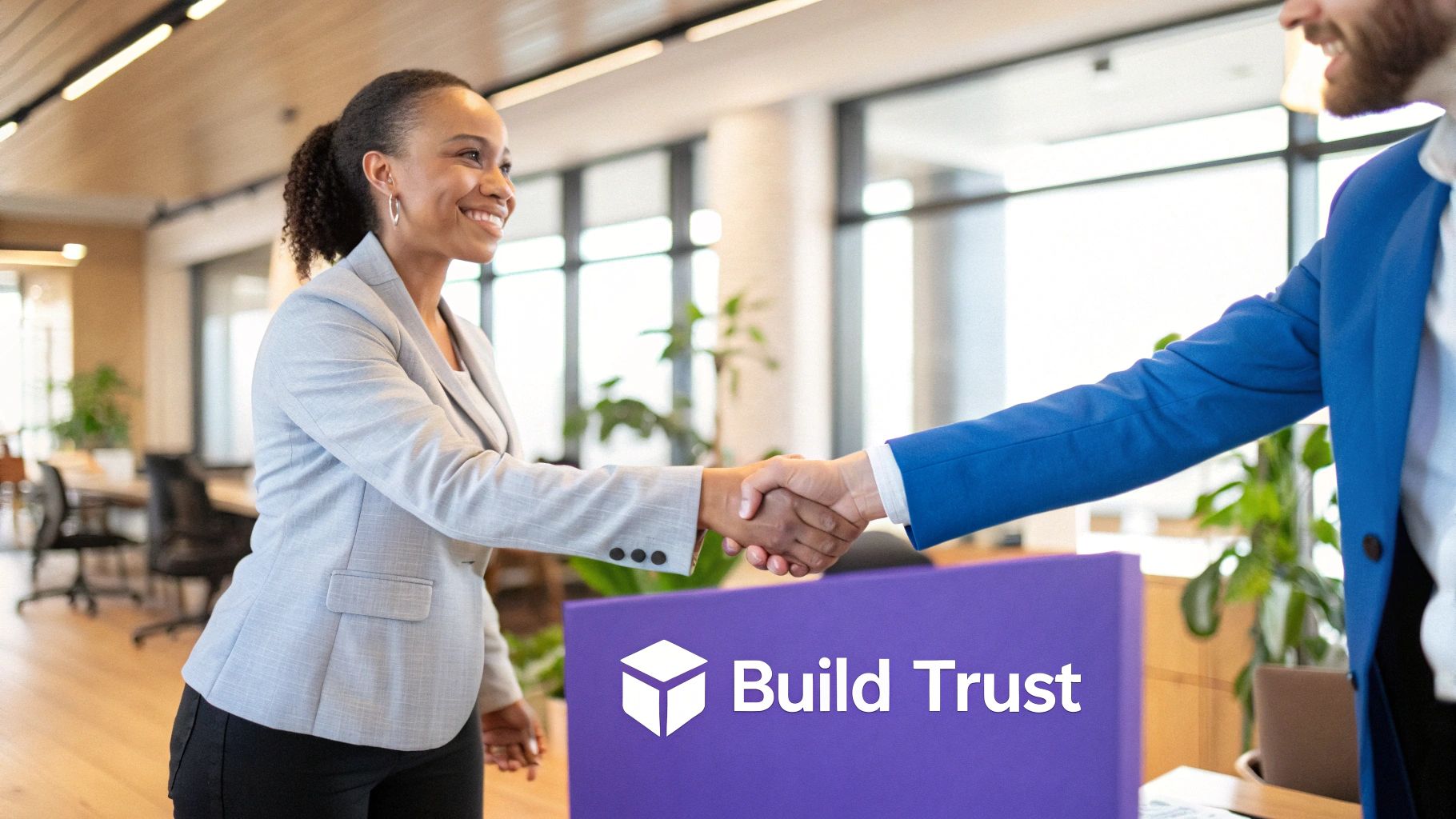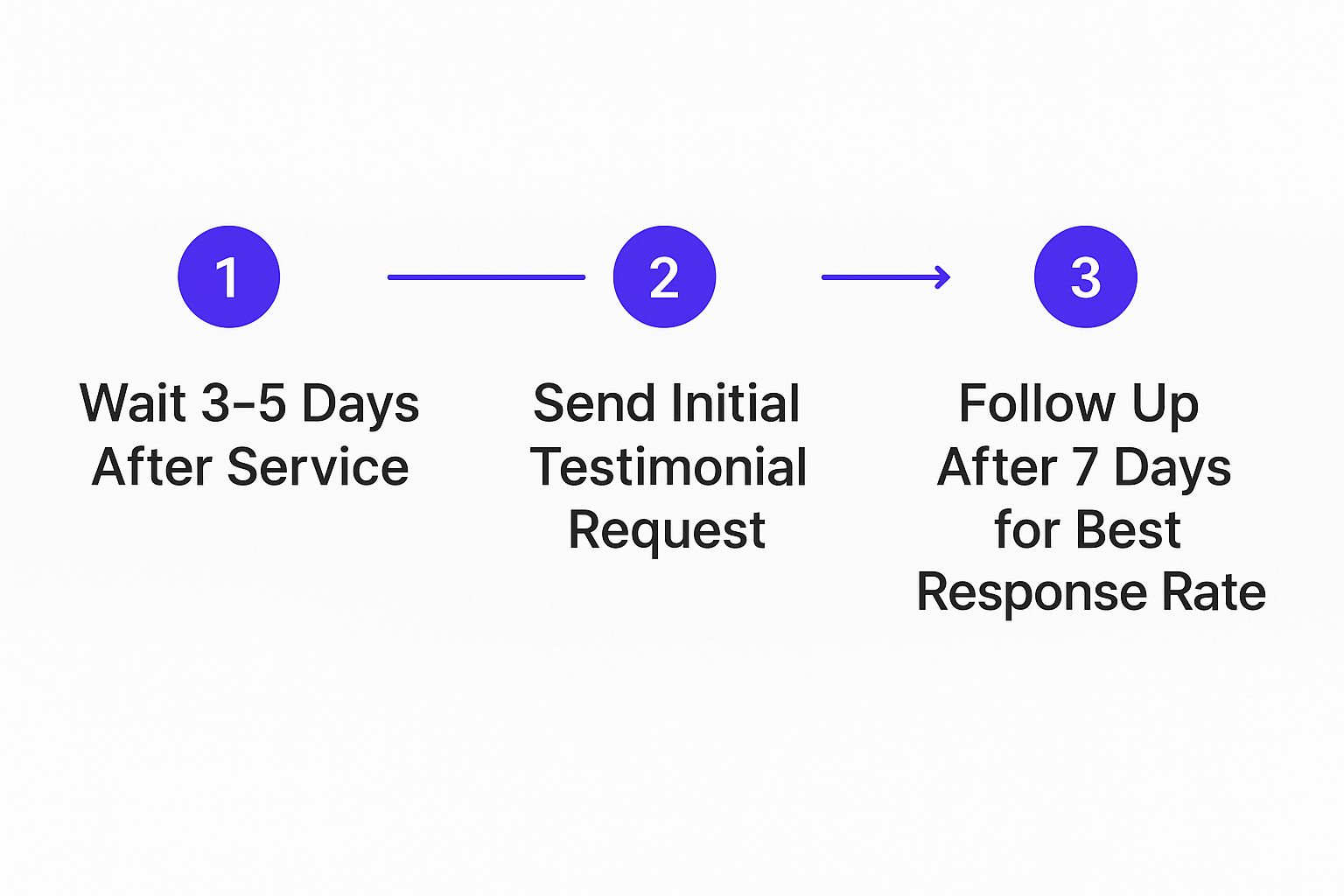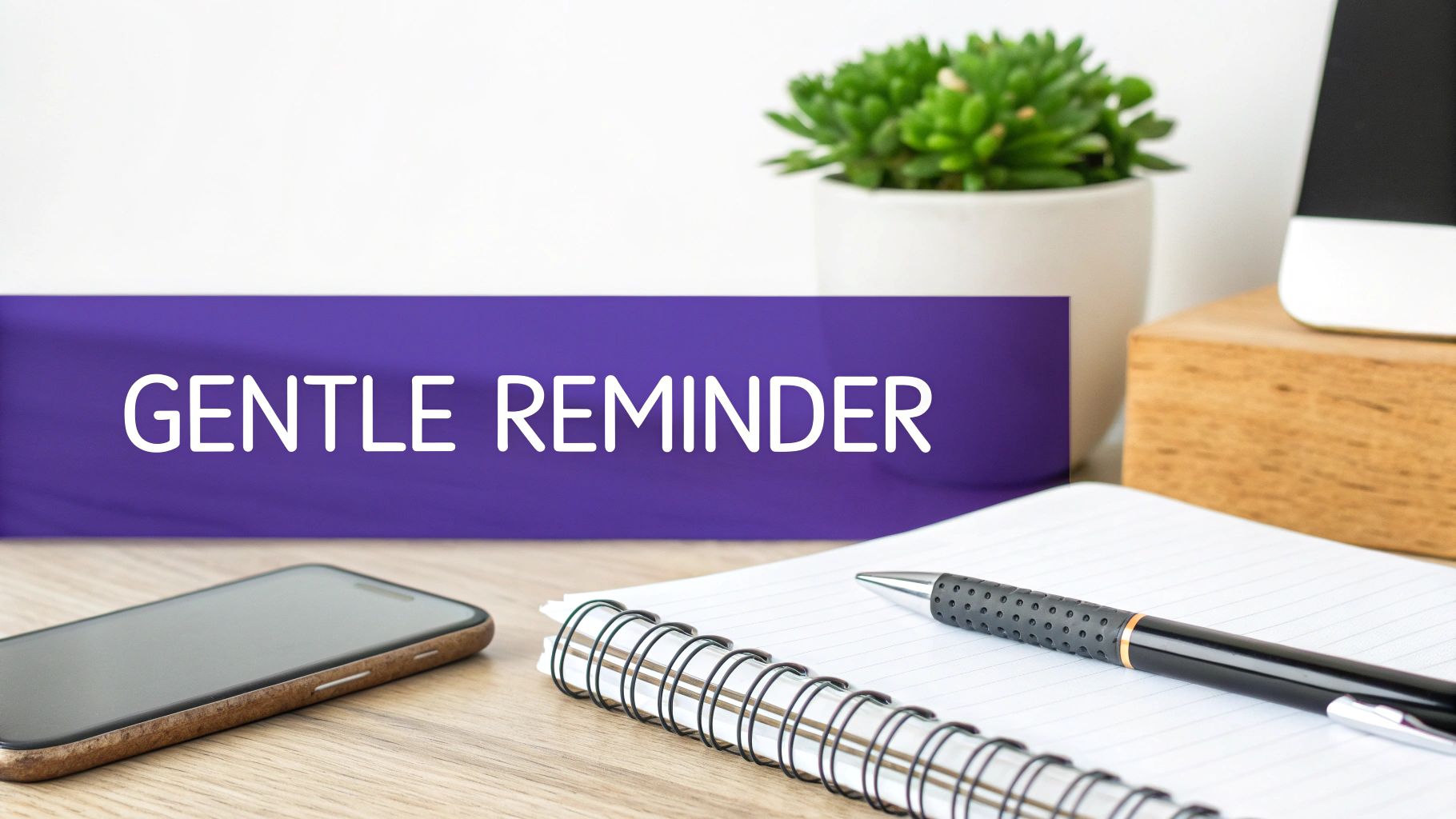How to Ask for a Testimonial That Gets Results
Learn how to ask for a testimonial with proven, real-world strategies. Discover the right timing, wording, and methods to get powerful customer stories.
Posted by
To really get a testimonial that lands, you have to make the ask feel personal, timely, and completely frictionless. Forget the generic templates. The magic happens when you reach out right after a great experience, mention that specific win, and make it ridiculously easy for your happy customer to share their thoughts.
The Real Value of Customer Testimonials

Before we jump into the "how," let's get crystal clear on the "why." A great testimonial is so much more than a nice quote to stick on your website. It's a genuine business asset that builds the trust you need to cut through buyer skepticism and shorten your sales cycle.
Think of it this way: potential customers are actively looking for reasons to believe in you. They want proof that your brand is the real deal—that you're reliable, trustworthy, and that your product actually does what you say it will. A glowing review from a real person is that proof.
More Than Just Kind Words
The impact of a solid testimonial goes way beyond just making you feel good about your work. It has a real, measurable effect on your bottom line. When you master asking for testimonials, you're not just collecting feedback; you're building an arsenal of marketing tools.
You can strategically deploy these authentic stories everywhere:
- On sales pages to dismantle specific objections right at the point of purchase.
- In ad campaigns to give your credibility an instant boost and drive more clicks.
- Across social media to create engaging content that builds trust on the platforms where your audience lives.
The data doesn't lie. Research shows a staggering 88% of customers trust online testimonials just as much as personal recommendations from friends. Even better, adding testimonials to sales pages can crank up conversion rates by an average of 34%. That’s a direct line from a happy customer's words to your revenue.
But here’s the secret sauce: the best testimonials come from strong relationships. It all starts when you build rapport with customers and boost loyalty. When that foundation exists, the ask feels natural, and the response you get is far more genuine and powerful.
Turning Skeptics Into Buyers
At the end of the day, testimonials work because they're relatable. A prospect sees someone just like them—someone who had the same problem, took a chance on your solution, and came out the other side with a fantastic result.
That narrative is incredibly persuasive. It lowers the perceived risk of making a purchase and transforms what could be a cold, transactional exchange into a warm, human-to-human connection. When you see testimonials through this lens, they stop being a "nice-to-have" and become a core part of your growth engine.
Pinpointing the Perfect Moment to Ask
When it comes to asking for a testimonial, timing isn’t just a factor—it's everything.
Ask too soon, and you come off as pushy or transactional. Wait too long, and that initial spark of excitement your customer felt has already faded. The real sweet spot is making your request feel like a natural, appreciative follow-up, not just another marketing task on your checklist.
You're looking for those "trigger points" in the customer journey where satisfaction is through the roof. These are the moments when your customer is genuinely thrilled or relieved because of what your product or service just did for them. If you can time your ask for that window of peak emotion, your chances of getting an enthusiastic "yes" skyrocket.
Think about it. You wouldn't ask a friend for a big favor right after they’ve had a stressful day. You'd wait for a better moment. The same goes for your customers.
Look for High-Value Milestones
For anyone in a service-based business, a major project milestone is a golden opportunity. The moment you deliver that slick new website design or wrap up a game-changing consulting project, your client's appreciation is at an all-time high. Their positive experience is fresh, making it the perfect time to capture their thoughts.
If you're a SaaS company, this moment might be right after a user crushes their onboarding and successfully uses a key feature for the first time. Say a customer uses your software to pull their first big sales report and tells your support team how awesome it was. That’s your cue.
A great move is to follow up a few days after a big win. Just a simple check-in to see how they're enjoying the results. If their reply is glowing, you’ve got the perfect opening.
A simple, “That’s fantastic to hear! We’re so glad you’re seeing results. Would you be open to sharing a few sentences about your experience that we could use as a testimonial?” often works wonders. It feels like a real conversation, not a canned request.
Capitalize on Unprompted Praise
Sometimes, the best moments to ask are the ones that fall right into your lap.
Has a customer ever sent you a random email just to say how much they love your product? Or maybe they tagged your brand in a rave review on social media?
These moments are pure gold. Your customer has already done the heavy lifting by putting their satisfaction into words. All you have to do is catch it.
Here are a few classic examples of unprompted praise creating the perfect opening:
- A happy support ticket: After your support team swoops in and solves a tricky problem, that customer is often feeling massive relief and gratitude.
- A public shout-out: When a client gives you props on LinkedIn or X (formerly Twitter), they're already acting as a brand advocate.
- An out-of-the-blue email: A spontaneous message of thanks is one of the clearest signals that you've made a real impact.
Don't let these moments slip by. A quick, appreciative reply followed by a gentle ask can turn that fleeting praise into a powerful, lasting asset. Nailing these key moments is crucial, and you can even automate your testimonial requests based on these triggers to keep a steady flow of social proof coming in.
Crafting a Request That Feels Personal
How you ask for a testimonial is every bit as important as when you ask. Let’s be honest, a generic, copy-paste request feels cold and transactional. It's the kind of email we all ignore because it's obvious we're just another number on a to-do list.
The goal here is to make your customer feel genuinely seen and appreciated. A truly effective request blends warmth, specificity, and clarity. It's less about following a rigid script and more about adding a personal touch that shows you actually remember them and value their specific experience. This doesn't just get you more responses—it gets you better, more authentic testimonials.
The Anatomy of a Personalized Ask
A killer request isn't complicated. It just needs a few key ingredients to make the customer feel valued and make it dead simple for them to say "yes."
Always start by using their name and referencing the specific win or positive moment they had with you. This instantly signals that this isn't a mass email blast. For example, instead of a bland "We'd love your feedback," try something like, "I was so thrilled to hear the new branding we developed has already brought you two new client inquiries!"
See the difference? That simple shift changes the entire dynamic.
Remember, the best testimonials often come from a natural back-and-forth. If a customer sends you a glowing email out of the blue, don't overthink it. Just ask, "This is so great to hear! Would you be comfortable with us sharing this as a testimonial on our site?" It’s often the easiest and most authentic path.
But even the most perfectly timed and worded request is useless if it never lands in their inbox. Before you even think about hitting send, you need to make sure your emails are actually getting delivered. Taking a few moments to reduce bounce rates for your testimonial email outreach is a critical first step.
The graphic below lays out a simple but effective timeline for your outreach.

This approach is all about patience and polite persistence. It gives your happy customer plenty of time to respond without ever feeling cornered or pressured.
To really nail your outreach, it helps to break down what makes a request email work.
Anatomy of an Effective Testimonial Request
This table breaks down the essential components of a powerful testimonial request email, explaining the purpose of each part.
| Email Component | Purpose and Key Elements | Example Snippet |
|---|---|---|
| Personalized Subject Line | Grabs attention and feels personal. Use their name or reference your project. | "Quick question about your experience, [Customer Name]!" |
| Specific Opening | Immediately reminds them of their success and shows this isn't a generic email. | "Hi [Customer Name], I was so excited when you told me you'd increased conversions by 15%!" |
| The Clear "Ask" | Be direct and explain why you're asking. People are more likely to help if they understand the impact. | "Your story would be so inspiring for others. Would you be open to sharing a brief testimonial about your results?" |
| Make It Easy | Remove all friction. Provide prompts or a direct link to guide them. | "To make it easy, you could just answer these two questions..." |
| Clear Next Step | Tell them exactly what to do. Provide a direct link to the review page or form. | "You can leave your thoughts right here: [Direct Link]" |
| A Warm Closing | End on a friendly, appreciative note. Reinforce that you value their time. | "Thanks again for everything, [Customer Name]. We loved working with you." |
By structuring your email this way, you're not just asking for a favor—you're continuing a positive relationship and making it incredibly easy for them to help you out.
Making It Frictionless
Once you've made that personal connection, the next step is to remove every possible bit of friction from the process. People are busy. Even your happiest customers will bail if it feels like work.
You have to guide them. Instead of a vague "leave a review," give them a few specific, open-ended questions to get the ball rolling. This simple trick eliminates the "blank page" paralysis that stops so many people.
Here are a few prompts you can steal and adapt:
- What was the biggest challenge you were facing before working with us?
- What specific result or improvement have you seen since using our product?
- What was your absolute favorite part of the entire experience?
By providing a clear path, you're doing the heavy lifting for them. If you need a hand turning their raw feedback into a polished quote, our guide on how to write a testimonial has some great tips for structuring compelling stories.
Finally, give them a direct link to the exact place you want the review. Whether it's a Google Business Profile, a product page, or a simple form on your site, send them straight there. The fewer clicks required, the better your chances of success.
So, You Want to Use Video Testimonials?

In a world drowning in visuals, nothing cuts through the noise like seeing and hearing a real person share their success story. Written quotes are great, but video testimonials create a human connection that builds trust almost instantly.
A lot of businesses hesitate here. They picture big budgets, production crews, and complicated setups. But that's just not how it works anymore.
The secret is making the whole process ridiculously simple for your clients. Let's be honest, asking someone to record a video can feel like a huge favor. You can completely change that by guiding them with specific, open-ended questions that pull out authentic stories, not stiff, rehearsed answers.
Making the "Video Ask" Feel Effortless
Your goal is to remove every ounce of intimidation your customer might feel. Ditch the vague "Could you record a video for us?" and give them a clear, simple path instead.
Modern tools and platforms have made video collection incredibly easy. Many let customers record right from their phone or laptop with a single click—no special software, no downloads, no friction.
To get those compelling narratives, frame your request around their journey. Think story-first.
- "Before you started with us, what was the one big problem you were struggling with?"
- "Can you describe that 'aha!' moment when you realized our solution was actually working for you?"
- "What's the single biggest result you've achieved that you're most proud of?"
See the difference? These kinds of questions prompt a story, not just a one-word answer. If you need some inspiration, check out these powerful video testimonial examples to see how others are using storytelling to build massive credibility.
By making it easy and guiding the narrative, you empower your customers to confidently share their wins.
Key Takeaway: The magic of video is its authenticity. Don't aim for a slick, highly produced commercial. A genuine, slightly imperfect video shot on a smartphone often feels far more trustworthy and relatable to your audience.
The Clear ROI of Customer Stories on Camera
The effort you put into gathering video testimonials pays for itself, and then some. These visual stories aren't just for your website's homepage. They're versatile assets you can slice and dice for punchy social media clips, add to email campaigns, or feature in detailed case studies that close high-value deals.
The data backs this up, big time.
One recent study found that 72% of marketers reported an ROI increase between 50% and 500% from using testimonial videos. It's not just an enterprise game, either. The same study showed 64% of small businesses saw conversion improvements of over 25%.
These numbers prove video isn't just a "nice-to-have" anymore. It's a proven revenue driver that forges a deeper, more human connection—and that connection directly translates into business growth.
Placing Testimonials for Maximum Conversion

Collecting powerful customer stories is a huge win, but let’s be real—your work isn't done yet. A fantastic testimonial tucked away on some forgotten page might as well not exist.
The real magic happens when you strategically place that social proof right where your customers make their most important decisions. It's about building a steady drumbeat of credibility at every single touchpoint, turning a visitor's casual interest into an active decision to buy. Think of it as placing a reassuring nod from a trusted friend right when your prospect needs it most.
High-Impact Homepage Placement
Your homepage is your digital handshake. It’s often a visitor’s first impression, and it’s the perfect spot to establish immediate trust. Dropping a few of your strongest, most compelling testimonials "above the fold" can make a massive difference.
These should be short, punchy quotes that get straight to the point. You want to showcase the value you provide, fast. For instance, if you sell time-saving software, a quote like, "This tool saves our team 10 hours every week" is infinitely more powerful than a generic "Great product!"
This initial dose of social proof tells visitors they’re in the right place and that others have already found success with you. It sets a positive, reassuring tone for their entire visit.
Aligning Testimonials with Calls to Action
Now for the money-maker. The most critical moments for social proof are right next to your calls to action (CTAs). When a user is debating a purchase, starting a trial, or booking a demo, they're often hit with a wave of last-minute hesitation. This is where a perfectly placed testimonial can neutralize those final objections.
Let’s get specific. Consider these strategic pairings:
- Pricing Pages: Put testimonials that scream ROI or value right beside your pricing tiers. A quote about how your service is "worth every penny" can reframe a higher price point as a smart investment instead of just a cost.
- Checkout Forms: A simple testimonial about a smooth checkout or lightning-fast shipping can be just the thing to reduce cart abandonment.
- Demo Request Forms: Feature a quote from a client who had an amazing onboarding experience. It’s the perfect encouragement for someone on the fence about signing up.
This kind of contextual placement is incredibly powerful. The numbers don't lie: testimonials placed next to higher-priced items can boost conversion rates by a staggering 380%. On top of that, consistently using testimonials can generate about 62% more revenue, and having at least 50 reviews on a product page can lift conversions by 4.6%.
A powerful, relevant testimonial placed next to a "Buy Now" button acts as the final nudge a customer needs. It answers the silent question, "Am I making the right choice?" with a resounding "Yes!" from a satisfied peer.
Beyond just boosting direct conversions, well-placed testimonials contribute to a better user experience. This can indirectly help to improve overall website visibility. When visitors see proof that others trust you, they engage more, stay longer, and are more likely to convert—all positive signals that build your site's authority.
Common Questions About Testimonial Requests
Even with the best game plan, asking for testimonials can get a little awkward. Things come up. Knowing how to handle these common situations confidently will make your whole process smoother and, most importantly, keep your customer relationships rock solid.
Let's dive into some of the most frequent questions I see. Think of this as your playbook for navigating the tricky parts with grace.
How Should I Handle Vague or Weak Feedback?
We've all been there. A happy customer sends back a response that’s friendly but… not very useful. You get a simple, "It was great!" or "We love the product." While the sentiment is appreciated, it doesn't have the specific punch you need for a compelling testimonial.
Don't just toss it aside. This is your chance to gently guide them toward the good stuff. Your best move is to reply with something positive and then ask a specific follow-up question.
For instance, you could try saying:
- "That's so great to hear! To help us understand better, what was the one specific feature that you found most helpful?"
- "We’re thrilled you're happy! If you don't mind me asking, what's been the biggest improvement you've seen since you started working with us?"
This approach shows you value their initial feedback while encouraging them to dig a little deeper for the kind of results-oriented details that make a story powerful. It’s how you turn a vague comment into truly usable social proof.
What if a Customer Asks to Edit Their Testimonial?
It happens all the time: a customer wants to review or even tweak the final version of their testimonial before it goes live. Your answer should always be a quick and enthusiastic, "Absolutely!"
Giving them final approval is a non-negotiable step in building trust. It shows you respect their words and how they’re represented. Never, ever post a testimonial without their explicit permission, especially if you’ve edited it down for clarity or length.
A Quick Note on Legality: While you probably won't be drafting formal contracts for a simple quote, you absolutely must have documented permission to use a customer's name, words, and photo for commercial purposes. An email where they clearly say something like, "Yes, that looks great, feel free to use it!" is usually all the proof of consent you need. Just be transparent about where and how you plan to feature their story.
How Can I Thank Customers in a Meaningful Way?
This one’s big. A customer took time out of their busy day to help your business grow. That deserves more than a generic "Thanks!"
A simple thank-you email is a great start, but if you want to leave a lasting impression, go a step further. A small, unexpected gesture can make them feel genuinely valued and turn a happy customer into a true brand advocate.
Here are a few ideas:
- A handwritten thank-you card. Seriously, this still works wonders.
- A small gift card to a local coffee shop.
- A public shout-out on your social media channels (tagging them, of course, if they’re comfortable with it).
This small effort closes the loop on a high note and strengthens your relationship for the long haul. It's an investment that pays back in loyalty.
Ready to stop awkward follow-ups and start collecting powerful testimonials on autopilot? EndorseFlow gives you the tools to gather authentic video and text testimonials effortlessly and turn them into compelling social media content. Start your 14-day risk-free trial today!